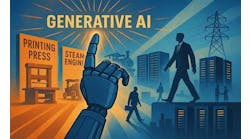Facing the Post-AI Energy Crunch: New Research Correlates Data Center Power Delays with Innovation Strategies
The AI boom has supercharged an already historic expansion of the data center sector — but one challenge now dominates all others: access to power.
In response, the industry’s first in-depth survey on the post-AI energy crunch has been released, providing a clear, data-driven view into the mounting energy constraints that are reshaping digital infrastructure.
Conducted by Data Center Frontier in collaboration with Schneider Electric and AlphaStruxure, the survey gathered insights from 149 senior industry leaders to understand how companies are confronting these challenges — and where they’re finding paths forward.
The results are timely, unambiguous, and revealing.
Power Access Becomes the Top Constraint
Grid limitations have vaulted to the forefront of development challenges. An overwhelming 92% of survey respondents identified grid constraints as the most significant obstacle slowing data center projects.
44% reported average utility wait times exceeding four years — a timeline that can derail even the most well-capitalized development strategies. Such data confirms what has been observed across the industry: in markets flush with demand and land, the bottleneck is now electrons, not entitlement.
Survey respondents also reported that these delays are no longer isolated to a handful of saturated markets; power interconnection challenges are becoming more widespread, affecting both established and emerging regions.
In fact, 61% of participants said they are now selecting sites primarily based on where power is immediately available — a reversal from past practices where network fiber, land cost, and tax incentives often led site selection criteria.
New Power Geography: Where Time-to-Power is Fastest
The survey data also surfaces important regional distinctions in how quickly power can be accessed:
- The Mountain West ranks highest for fastest time to power, offering shorter utility timelines that are increasingly rare in traditional Tier I markets.
- The Midwest has emerged as the leading region for “Plan B” power availability, indicating a growing shift toward secondary markets with untapped or underutilized grid capacity.
This reordering of market viability suggests that power availability — not just site readiness or fiber — is becoming a primary filter for site selection.
On-Site Power Goes Mainstream
Faced with extended grid delays, data center developers are increasingly turning to on-site power generation to meet aggressive AI-driven timelines.
Six in ten survey respondents said they would deploy on-site generation systems if utility power were not available in time — making it the most-preferred contingency strategy. These systems are no longer viewed as backup assets, but as front-line infrastructure to ensure project viability.
The survey revealed how natural gas microgrids, solar-plus-storage, and hybrid generation platforms are now under consideration at the earliest phases of data center site planning.
Many operators see these assets not just as stopgap measures, but as long-term enablers of resilience, emissions reduction, and cost control.
The Energy Cost Curve and Carbon Pressures
In addition to time-to-power, the survey explored the wider implications of the energy crunch:
- The energy demand from AI workloads is now driving a substantial share of total site requirements, altering load profiles and planning assumptions.
- Respondents expressed concern about emissions performance and long-term energy cost volatility, both of which are exacerbated by grid congestion and market uncertainty.
- There is growing interest in Distributed Energy Resources (DERs), including battery storage and smart energy management, to hedge against risk while enhancing sustainability.
Taken together, these concerns point to a fundamental rethinking of how data centers approach energy strategy in the AI era. Rather than relying solely on traditional grid connections, operators are increasingly exploring hybrid models that blend utility power with on-site generation, storage, and load flexibility.
This diversification not only improves resilience and predictability, but also positions operators to meet stricter ESG targets and future-proof their operations against rising costs and regulatory pressures.
AlphaStruxure’s Role: Delivering Energy as a Service
In sum, the new report confirms how, as AI accelerates the scale and urgency of infrastructure deployment, energy strategy has moved from a behind-the-scenes concern to a central driver of competitive advantage.
The survey comes at a time when energy infrastructure itself is undergoing reinvention. AlphaStruxure — a joint venture between Schneider Electric and investment firm Carlyle — is positioned at the forefront of this shift.
By designing, building, owning, operating, and maintaining energy infrastructure over the long term, AlphaStruxure delivers a differentiated Energy as a Service (EaaS) model.
This approach removes CapEx barriers, while ensuring clients benefit from high-performance systems aligned with long-term outcomes like resilience, reliability, cost predictability, and greenhouse gas reduction.
Unlike traditional utility models or short-term equipment leasing, AlphaStruxure’s lifecycle approach gives data center operators a strategic partner fully invested in long-term site performance.
Toward a New Power Strategy for the AI Era
With U.S. data center energy demand expected to double by 2030, the pressure to rethink power procurement models is intensifying. The new survey report — the first of its kind to quantify how the data center industry is adapting to the post-AI energy crunch — provides more than a snapshot of this situation. It offers a benchmark for where the industry is now, and where it's going.
From time-to-power delays and regional shifts, to the rise of on-site generation and new financial models, the message is clear: traditional paths to data center power are no longer sufficient. Innovation in infrastructure, financing, and strategy will define the next phase of industry growth.
Download the full report to explore all findings and insights.
At Data Center Frontier, we talk the industry talk and walk the industry walk. In that spirit, DCF Staff members may occasionally use AI tools to assist with content. Elements of this article were created with help from OpenAI's GPT4.
Keep pace with the fast-moving world of data centers and cloud computing by connecting with Data Center Frontier on LinkedIn, following us on X/Twitter and Facebook, as well as on BlueSky, and signing up for our weekly newsletters using the form below.

Matt Vincent
A B2B technology journalist and editor with more than two decades of experience, Matt Vincent is Editor in Chief of Data Center Frontier.





